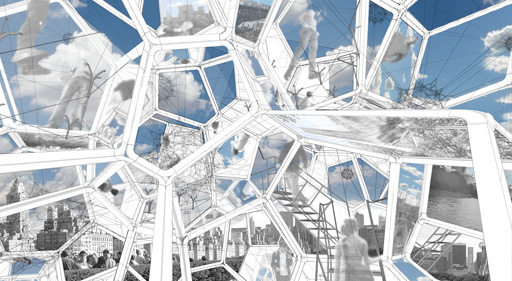
In 1945 Buckminster Fuller erected a geodesic dome the size of large hut on the campus of Bennington College in Vermont. Built from aluminum aircraft equipment and vinyl, the structure was said to support its own weight and more. Supposedly, Fuller suspended a number of his students from the dome to demonstrate its superior endurance and weight bearing abilities. His unconventional design quickly gained notice, most notably from the U.S. government, which used it to create portable emergency shelters. The design has also served as a source of inspiration for many artists and designers. Argentinian-born Tomas Saraceno is one of them.
Saraceno’s latest artistic installation, a 20-ton constellation of shimmering stainless steel modules built on roof of the Metropolitan Museum of Art, echoes themes central to Buckminster’s vision: art inspired by science, science inspired by art. Visitors of the Escher-like installation are invited to walk inside and experience for themselves its unsettling sense of weightlessness. Carol Vogel of the New York Times writes:
Like many of Mr. Saraceno’s installations “Cloud City” is his vision of floating or flying cities—places that defy conventional notions of space, time and gravity. “You can have a feeling of weightlessness that’s a bit disorienting,” he admitted.
.Cloud Cities is not Saraceno’s first crack at science-inspired art, Vogel notes:
Anne L. Strauss, associate curator in the Met’s modern and contemporary art department, first saw Mr. Saraceno’s work at the 2009 Venice Biennale, where molecular webs of black elastic rope enveloped a large white gallery in the main building of the Giardini. The strands themselves were complex crystalline shapes, making the installation as architectural as it was philosophical. The spider’s web, whose shapes can be so easily destroyed, were Mr. Saraceno’s metaphor for the fragility of the world. “After I saw that piece, I thought, given his unfettered inventiveness, Tomás would be the ideal artist to create something for this site,” Ms. Strauss said, adding that “Cloud City” would be “similar to a telescope looking into the atmosphere.”
Join us on Thursday, May 31, at the Met for Artist as Innovator: Visions of a Floating City when Saraceno explores the evolving relationship between science and art with renowned spider expert Peter Jager, astrophysicist Mario Livio, astrobiologist Christopher McKay and architect Mark Wigley.